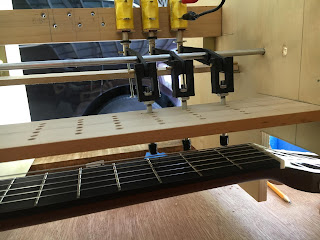I enjoyed making the MIDI Pipe Organ that I described in earlier posts on this blog titled Music & Me Parts 1 through 5. I brought the Organ to a couple of Orlando (Fla.) Maker Faires. It was well received. In fact, the second year that I went a couple of people told me that they came back looking for the Organ specifically, having seen it the previous year. The problem is that the Organ has forty-two separate pipes, plus the wind chest/base, plus the blower. It's heavy to move around, and time consuming to set up and take down, and complicated to transport. I thought I'd try to make something a little more portable, and a guitar came to mind. That was my first mistake.
Here we are, two years later, and only now are things starting to come together. I can, however, tell you a bunch of ways
not to make a self-playing guitar. Before I get into my story, though, I have posted a rough video on YouTube for those of you who want to hear the guitar but aren't interested in how I got there, and you can see it
here. (I will also work on my spelling.)
There are, of course, two parts (hands) involved in playing the guitar, the picking typically done with the right hand, and the fretting typically done with the left. While I worked on these concurrently I think the story will be easier to follow if I talk about the picking first, and then the fretting.
This was one of my early attempts. I used hobby servos, attached arms to them, and attached guitar picks to the arms. The problem I had here was that sometimes the pick would bend, but not snap over the string. I would then lengthen the stroke. Unfortunately, if the arm swung far enough to pluck the string often the pick would wind up in contact with the adjacent string.

OK, no problem. I would just make the picks stiffer so they wouldn't bend so much. Here is a picture of the next version. That seemed to work pretty well, until I started fretting the strings. Because there was no flex in the picks their positioning was critical. If they caught too much string they would just drag the string along with them. If the strings were open (unfretted) they worked fine. However, when they were fretted the string would be pushed closer to the guitar and the pick would barely catch the string or miss it completely. I was not able to find a setting that worked consistently.


So next I went back to the flexible picks. But this time I changed the mechanics. Here is a drawing that might help me explain. The blue boxes are the servos, the red lines are the picks. The black dots are meant to represent the six strings of the guitar, but try to picture that you are looking right down the string, such that it is coming out of the page. If you can picture that you can see that when the pick is swung to the left as in Position 1 it doesn't interfere the the next string. As the pick starts to swing it will hit its string as in position 2. Finally, in position 3 it can't interfere with the string on the other side.
This scheme still requires careful adjustment of the height of the picks but they can be set such that they consistently pick an open or fretted string without coming in contact with adjoining strings.
Alright, so that's the design that settled on for picking the strings. Ultimately the speed of the guitar will be limited by (among other things) the speed of the servos and the lengths of the strokes. I don't think I'll be able to compete with Slash or Jimmy Page but as the Brits say, "The best is the enemy of the good."
In my next post I'll fret about fretting.
 In the picture to the right you can see the plastic pipe that connects the vacuum pump to the solenoid valves, and thence to the pneumatics. Connected to each of the pneumatics is a wire. When the vacuum is applied to a particular pneumatic it pulls on the wire.
In the picture to the right you can see the plastic pipe that connects the vacuum pump to the solenoid valves, and thence to the pneumatics. Connected to each of the pneumatics is a wire. When the vacuum is applied to a particular pneumatic it pulls on the wire.












